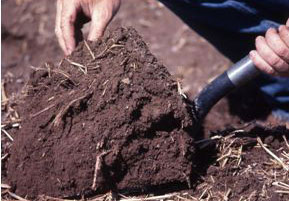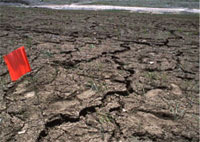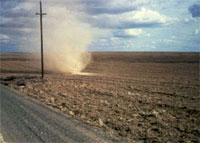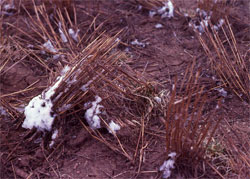Soils

Soil rich in organic matter
Soil is composed of sand, silt, clay, and organic matter. Each component varies greatly from place to place. Soils are important because they hold moisture and nutrients which are needed for vegetation and crops to grow. Soil types vary in their water holding capacity and their productivity.
What soil types are on my property?
Check out the Colorado Natural Resources Conservation Service (NRCS) Web Soil Survey.
Click on start WSS and navigate by your address.
What can I do to make my soil healthier?
The Hope in Healthy Soil
8-part video series highlights many of the important principles and practices behind growing soil health in your farm field or backyard.
- Reduce Soil Erosion: Protect soil from erosion by maintaining a healthy stand of vegetation which will hold the soil in place and allow rain water to infiltrate into the soil rather than run off. Simply minimize the size and number of bare spots on your land. Protecting soils from erosion is important because grass and other vegetation need soil in order to grow productively. Wind can blow soil away and water can wash across land taking soil with it.
Water Erosion Wind Erosion 

 Soil Water Management: Protecting soils from erosion can also allow soils to capture more available moisture. Increase soil moisture by maintaining a larger amount of crop stalk or grass in the Fall. The extra vegetation will hold more snow, and thus keep more moisture on your property.
Soil Water Management: Protecting soils from erosion can also allow soils to capture more available moisture. Increase soil moisture by maintaining a larger amount of crop stalk or grass in the Fall. The extra vegetation will hold more snow, and thus keep more moisture on your property.- Add compost to your soil: Composting is a wonderful strategy to create free and nutrient-rich soil usable in your garden and houseplants. Click here for more information.
- Test soil for nutrient and organic matter: Many nutrients and macronutrients are available in soil at various proportions. It is important to take a soil test every year to determine if additional fertilization is needed. In general, native range grasses may not need additional fertilization. Grass litter and the manure droppings during grazing will provide enough nutrients for native grasses. However, irrigated and introduced grasses will need additional nutrients. Soil test kits can be ordered from the Colorado State University Soil, Water, and Plant Testing Lab.
- Reduce Soil Compaction: Roots need to be able to grow deep into the soil. When soil is compacted roots may not be able to find the moisture or the nutrients they need to thrive. You can reduce soil compaction by minimizing traffic or grazing when the soil is wet.
Learn more about Soil Quality and improving how your soil works.
Resources
Resources & Helpful Information
SAM Webinars and Web Videos
SAM Newsletter Articles
- Introduction to N-P-K on a Compost Test – spring 2021
- Soil Health – winter 2020
- Carbon Coating Gives Biochar Its Greening Power – winter 2018
- Uncovering the Mystery of Cover Crops – spring 2017
- 811: Know What’s Below. Call Before You Dig – fall 2016
- Soil: It’s Alive! STEM Kit and Curriculum – summer 2016
- How to Manage for Healthy Soil – fall 2015
- How Healthy Is Your Soil? – summer 2015
- What is Soil and How Does it Form? – spring 2015
- Soil Health and Vermicompost – spring 2015
- Why Do Soils Matter? – winter 2015
- What Is Soil Heath & Why Should I Care? – winter 2014
- A Menu of Organic Fertilizers – fall 2012
- Tillage and Compaction – spring 2010
- Living Soil – summer 2009
- Soil Testing – fall 2009
CSU Extension Fact Sheets
- Diagnosing Saline and Sodic Soils
- Estimating Soil Moisture by Feel and Appearance
- Managing Saline Soils
- Managing Sodic Soils
- Zinc and Iron Deficiencies
More Information on Soil
- NRCS Soil Quality – Learn about organic matter, soil biology, and how to best manage your soils
- Web Soil Survey – Learn about the soils on your property
- Rainfall Simulator – NRCS rainfall simulator on how soil health practices improves soil health and water cycle in croplands and pasture lands.





